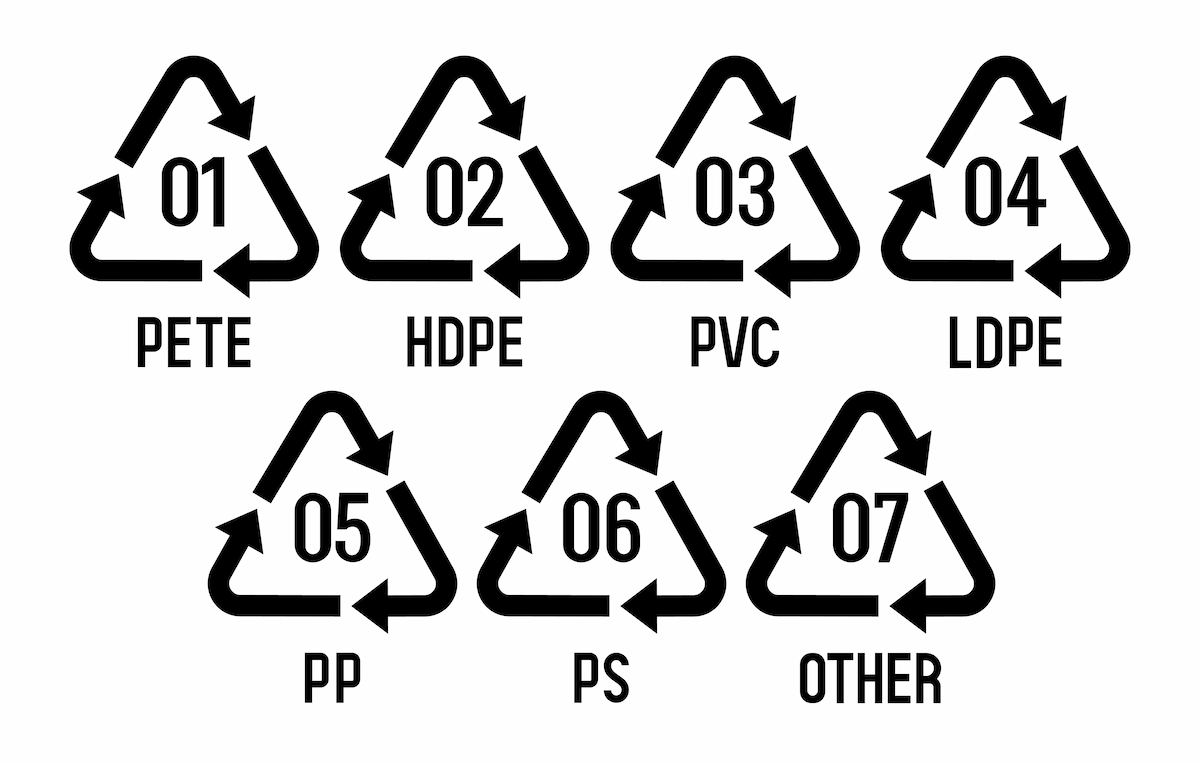Table of Contents
Have you ever noticed the recycling symbols numbered 1–7 on plastic packaging? These numbers are plastic codes and indicate the type of plastic used. Each code has different properties. To find out what these codes mean, read the explanation below.
Plastic Codes You Need to Know
To better understand when choosing plastic packaging, it is crucial to understand the meaning of the recycling codes, usually printed on the bottom. Understanding plastic types can also help support better plastic waste management.
According to data from the Sistem Informasi Pengelolaan Sampah Nasional in 2024, waste management in 317 regencies/cities in Indonesia has reached 59.74%. Meanwhile, the remaining 40.26% are still in the process of improving their management.
Knowing plastic types is a simple step you can take to support better waste management. Let’s learn the meaning of the following plastic codes.
1. PETE or PET (Polyethylene Terephthalate)

The recycling symbol with the number 1 and the code PETE or PET indicates polyethylene terephthalate plastic. This type of plastic is commonly used in water bottles, oil bottles, sauce containers, jam containers, and even medicine boxes. Typically, plastic with this code is only used once.
2. HDPE or PEDH (High-Density Polyethylene)

The recycling symbol with the number 2 and the code HDPE or PEHD indicates high-density polyethylene plastic. This type of plastic is commonly used for water gallons, milk bottles, soap bottles, shampoo, detergent, and thick plastic packaging.
HDPE plastic is considered relatively safe and can be reused due to its easy recycling process and economic value.
3. PVC or V (Polyvinyl Chloride)

The number 3 with the code PVC or V indicates plastic made from polyvinyl chloride. This plastic is typically used for non-food purposes, such as pipes, tiles, cables, plastic wrap, and even children’s and pet toys.
Read also: The Youth Must Care About the Environment
4. LDPE atau PE-LD (Low-Density Polyethylene)

The recycling symbol with the number 4 and the code LDPE or PE-LD indicates low-density polyethylene plastic. This type of plastic is commonly used for shopping bags, plastic bags, food wrappers, and trash bags.
LDPE plastic is known for its flexibility and strength, allowing it to be reused more than once. However, to avoid adding to the waste volume, it’s best to collect this plastic immediately after use for recycling.
5. PP (Polypropylene)

The number 5 and the code PP indicate polypropylene plastic. This plastic is often used for food containers, syrup bottles, yogurt containers, straws, tape, and even plastic rope.
PP plastic has good durability and is not easily damaged by heat. Due to its strong and stable properties, this plastic is one of the plastic bottle codes that is safe for repeated use, especially for storing food or drinks.
6. PS (Polystyrene)

Plastic with the number 6 and the code PS is a type of plastic made from polystyrene. This plastic is known for its lightweight nature and is often used for various everyday needs, such as styrofoam, protective packaging (foam), and even building flooring materials.
7. Other or O

The recycling symbol with the number 7 and the code Other or O is used for plastics that do not fall into the previous six types, such as PET, HDPE, PVC, LDPE, PP, or PS. This type of plastic is usually mixed materials or is made for special needs.
You can find it in baby bottles, sports bottles, electronic device casings, and even CDs. Because of its diverse properties, it is a good idea to read the label or instructions first to determine whether the plastic is suitable for food, drinks, or other purposes.
How to Recycle Plastic Waste
Now that you are familiar with the various types of plastic, it is also important to know how to manage it. If managed properly, plastic waste can still be used for something useful. Here are some ways you can recycle plastic waste:
1. Recycle Plastic Waste into Works of Art
One creative way to recycle plastic waste is to turn it into valuable works of art. For example, you can transform used plastic bottles into flower decorations, while bottle caps can be turned into unique key chains or wall decorations. This way, plastic waste is not only managed but also properly transformed into valuable items that beautify your room.
Read also: What Is Organic Waste? Find Out the Types and Benefits!
2. Dispose of it to an Integrated Waste Management Center
If you do not have the time or facilities to recycle your plastic waste yourself, you can hand it over to an integrated waste management center. They will collect and process the plastic waste you hand over.
One example is IPST ASARI, a program from the Chandra Asri Group. IPST ASARI, or Industri Pengelolaan Sampah Terpadu—Atasi Sampah, Kelola Mandiri, aims to reduce the accumulation of waste in landfills.
This program collects waste from households and industries and then sells it to a recycling plant. The plastic waste is processed into fuel used by fishermen for boats and cooking.
Interestingly, IPST ASARI is run by the local community, specifically members of the KSM Sehati Maju Bersama, who have received special training in plastic waste processing.
3. Process Plastic Waste into CIRCLO

Processing plastic waste into CIRCLO is an innovative method of recycling, especially for HDPE plastic. HDPE plastic is known for its strength and durability, making it suitable for use as a mixture in asphalt production.
Through this program, HDPE plastic bags are shredded and processed into CIRCLO, which is then used as a mixture for road asphalt. It aims to empower local recyclers and plastic waste traders to produce asphalt raw materials that meet quality standards.
In addition, the Chandra Asri Group provides training to asphalt mixing plants and contractors, enabling the effective use of CIRCLO in road construction.
This way, plastic waste is not only managed but also adequately transformed into valuable products for infrastructure.
4. Make Flower Pots

Another way to recycle plastic waste is to make flowerpots. This method is simple and can be done by anyone. You can simply use plastic bottles, such as water, juice, or milk bottles. Then, you can make a hole in the bottle large enough and attach a string so the bottle can be hung. Next, fill the bottle with soil and plant your desired flowers or plants, then hang it in a suitable location.
5. Process Plastic Waste into Ecobricks
The final tip for recycling PET plastic is to make ecobricks. Ecobricks are plastic bottles filled with pieces of plastic waste. To make it, you can cut or chop the plastic waste into small pieces, then pack them into the plastic bottle until it is compact and filled. Finished ecobricks can be used for various purposes, such as making chairs and tables, or as additional building materials.
Those explained the plastic codes and how to manage them. By understanding the types of plastic and how to process them, you can be more mindful of your everyday plastic use.
If you care about the importance of waste management and want to contribute directly to creating a cleaner and healthier environment, you can join Indonesia Asri.
Through the #SiPalingSustainable campaign, Indonesia Asri invites you to participate in various exciting challenges that encourage a sustainable lifestyle and build a more beautiful and comfortable environment for all.
Register now and become part of the Warga Asri, ready to contribute to preserving the Earth!
Read also: How to Get Rid of Trash: Proper Ways You Should Know!








